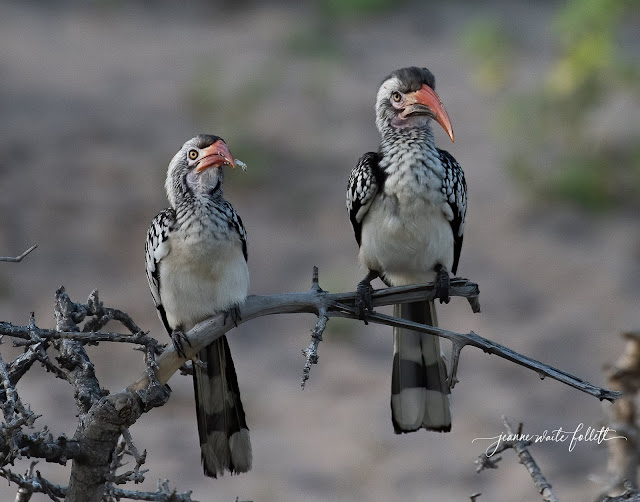Chapter Six
Hippos and Hornbills
Have you ever wondered what the decibel level would be like
if you were standing 15 feet away from the speakers at a rock concert? For an authentic approximation, stand next to a hippopotamus and listen to its grunts,
groans, growls, wheezes, and chuffs.
Better yet, save your hearing and your life by
lying in bed in your tent and enjoy the hippo serenade from the nearby waterway.
On a game drive one morning in Chobe National Park, we stop to watch these rotund animals frolicking
and splashing in their small pool, all of which involve wide-open mouths. Inside those gaping mouths are some fearsome
weapons.
The front teeth, the incisors, grow outward and can
reach more than a foot in length. The canines, though, called tusks, can be close to a foot and a half and are extremely
sharp and deadly.
The juveniles we watch do not appear to have grown
those weapons of mass destruction yet, so their play is just joyous to watch. Though their name is derived from the Greek
word for river horse, and they resemble pigs, the hippo is more closely related
to whales and dolphins.
 |
| No sign of the deadly teeth in this juvenile's mouth. |
How many photos of playing hippos do I want, I ask myself. I notice action in other parts of the pond
and pretty soon I’m trying to catch photos of hippo farts.
Yes, farts.
They are herbivores. Adults eat about 90 lbs. of grass every night. Imagine the gas they can pass. Adults are taller than I am at the shoulder
and weigh between 3000 and 9000 lbs.
Since they spend about 16 hours a day in the water, what do you suppose
happens when they need to release that air?
Hippos are not all fun and games and methane farts, however. They kill hundreds of people in Africa every
year. Not only can the beast run 20 mph
but they are just plain ornery and territorial. They attack boats and crush anyone they
grab.
So let’s move on.
Down the road a-ways, we spot a juvenile and an adult
red-billed hornbill sitting on some dead branches. The larger bird has something in its bill
that it transfers to the juvenile, then flies a short distance to forage on the ground.
When she returns with another insect, junior refuses
to take it. Mom gets frustrated. She holds the insect high in the air and
then swoops down to junior like she’s playing, “Here comes the plane. Open wide.”
Junior refuses.
Mom insists. Junior reluctantly
accepts the insect, which I think is a brown locust, but holds it in its beak
for a long time. Mom waits until he
swallows, then goes off to find more.
When you think about what mom went through to raise this little guy thus far, you can understand her exasperation. First, she must find a hole in a tree. Then, she lays three to six eggs and seals up the entrance to the nest, leaving only enough room for the male to transfer food to the female.
When the hatchlings are getting too large for the female and them, the female breaks out of the nest and it is again sealed up except for a narrow aperture through which food is passed to the chicks by both parents. When the chicks fledge, another break-out ensues.
While this female is off hunting, junior moves to a tree where we can’t
see him clearly. Mom returns and lands
in a tree about fifty feet from him and starts calling for him. Junior won’t answer. Little twerp.
She’s still calling as we drive away. I think he was holding out for pizza.























Nice and so informative. Very nice. Cap and Patti
ReplyDeleteThe young Hippos look like they are laughing and having tons of fun. Another great blog.
ReplyDelete